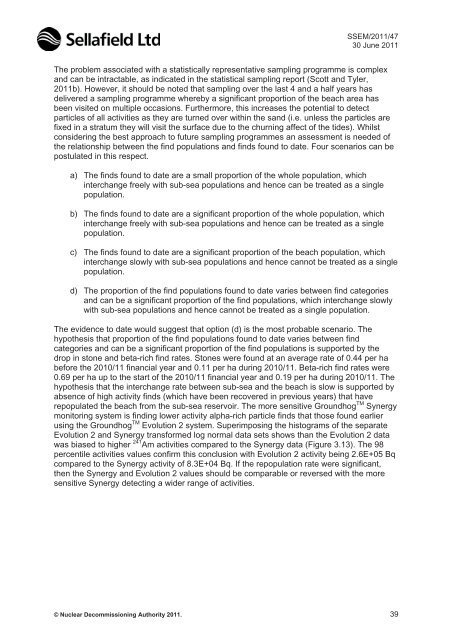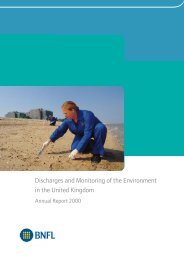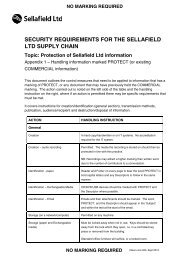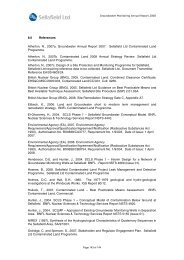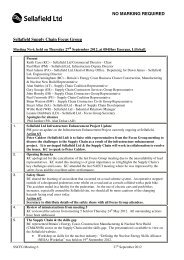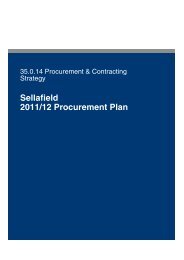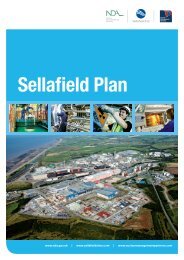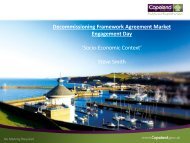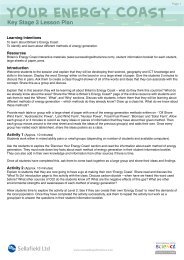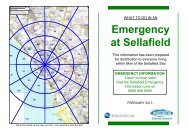Annual Report for 2010/11 and Forward Programme - Sellafield Ltd
Annual Report for 2010/11 and Forward Programme - Sellafield Ltd
Annual Report for 2010/11 and Forward Programme - Sellafield Ltd
You also want an ePaper? Increase the reach of your titles
YUMPU automatically turns print PDFs into web optimized ePapers that Google loves.
SSEM/20<strong>11</strong>/4730 June 20<strong>11</strong>The problem associated with a statistically representative sampling programme is complex<strong>and</strong> can be intractable, as indicated in the statistical sampling report (Scott <strong>and</strong> Tyler,20<strong>11</strong>b). However, it should be noted that sampling over the last 4 <strong>and</strong> a half years hasdelivered a sampling programme whereby a significant proportion of the beach area hasbeen visited on multiple occasions. Furthermore, this increases the potential to detectparticles of all activities as they are turned over within the s<strong>and</strong> (i.e. unless the particles arefixed in a stratum they will visit the surface due to the churning affect of the tides). Whilstconsidering the best approach to future sampling programmes an assessment is needed ofthe relationship between the find populations <strong>and</strong> finds found to date. Four scenarios can bepostulated in this respect.a) The finds found to date are a small proportion of the whole population, whichinterchange freely with sub-sea populations <strong>and</strong> hence can be treated as a singlepopulation.b) The finds found to date are a significant proportion of the whole population, whichinterchange freely with sub-sea populations <strong>and</strong> hence can be treated as a singlepopulation.c) The finds found to date are a significant proportion of the beach population, whichinterchange slowly with sub-sea populations <strong>and</strong> hence cannot be treated as a singlepopulation.d) The proportion of the find populations found to date varies between find categories<strong>and</strong> can be a significant proportion of the find populations, which interchange slowlywith sub-sea populations <strong>and</strong> hence cannot be treated as a single population.The evidence to date would suggest that option (d) is the most probable scenario. Thehypothesis that proportion of the find populations found to date varies between findcategories <strong>and</strong> can be a significant proportion of the find populations is supported by thedrop in stone <strong>and</strong> beta-rich find rates. Stones were found at an average rate of 0.44 per habe<strong>for</strong>e the <strong>2010</strong>/<strong>11</strong> financial year <strong>and</strong> 0.<strong>11</strong> per ha during <strong>2010</strong>/<strong>11</strong>. Beta-rich find rates were0.69 per ha up to the start of the <strong>2010</strong>/<strong>11</strong> financial year <strong>and</strong> 0.19 per ha during <strong>2010</strong>/<strong>11</strong>. Thehypothesis that the interchange rate between sub-sea <strong>and</strong> the beach is slow is supported byabsence of high activity finds (which have been recovered in previous years) that haverepopulated the beach from the sub-sea reservoir. The more sensitive Groundhog TM Synergymonitoring system is finding lower activity alpha-rich particle finds that those found earlierusing the Groundhog TM Evolution 2 system. Superimposing the histograms of the separateEvolution 2 <strong>and</strong> Synergy trans<strong>for</strong>med log normal data sets shows than the Evolution 2 datawas biased to higher 241 Am activities compared to the Synergy data (Figure 3.13). The 98percentile activities values confirm this conclusion with Evolution 2 activity being 2.6E+05 Bqcompared to the Synergy activity of 8.3E+04 Bq. If the repopulation rate were significant,then the Synergy <strong>and</strong> Evolution 2 values should be comparable or reversed with the moresensitive Synergy detecting a wider range of activities.© Nuclear Decommissioning Authority 20<strong>11</strong>. 39


